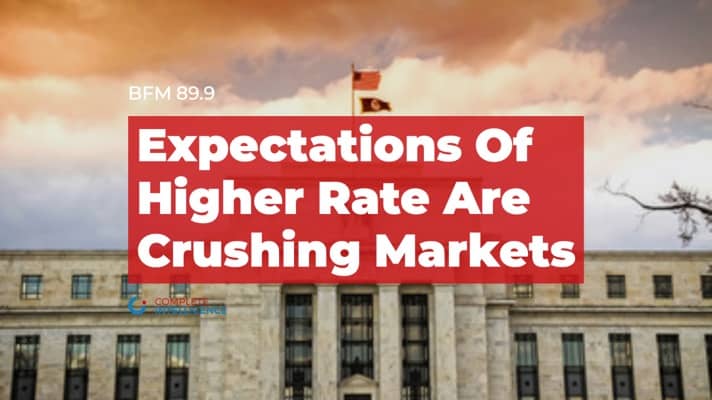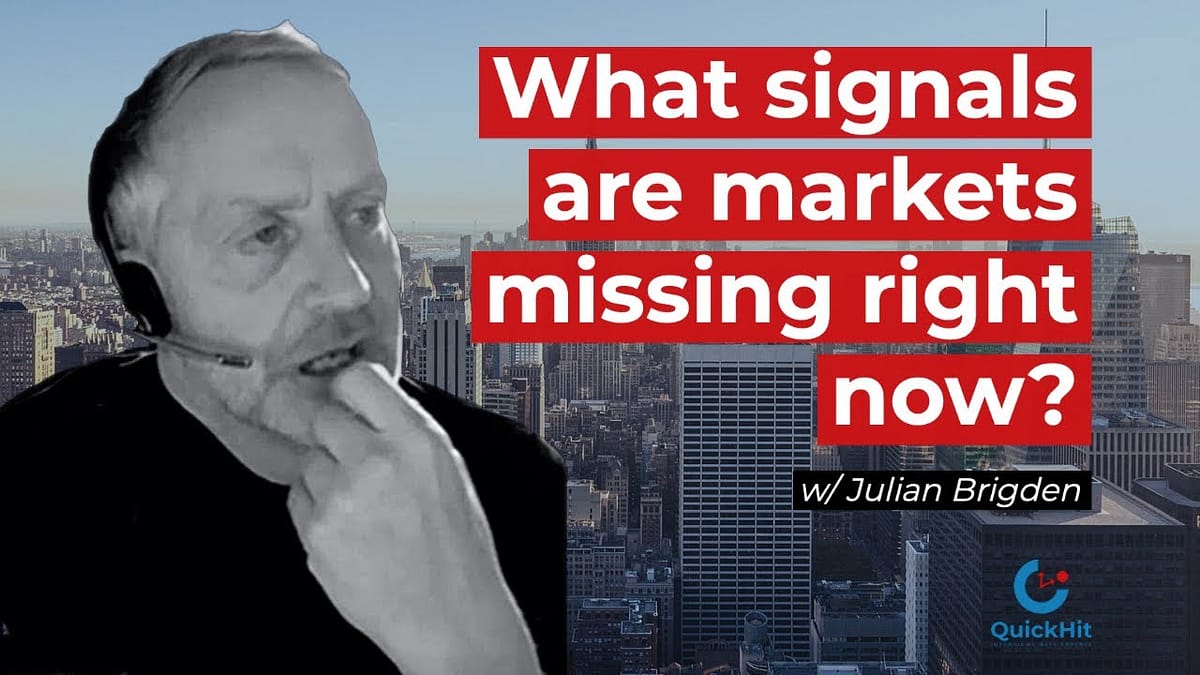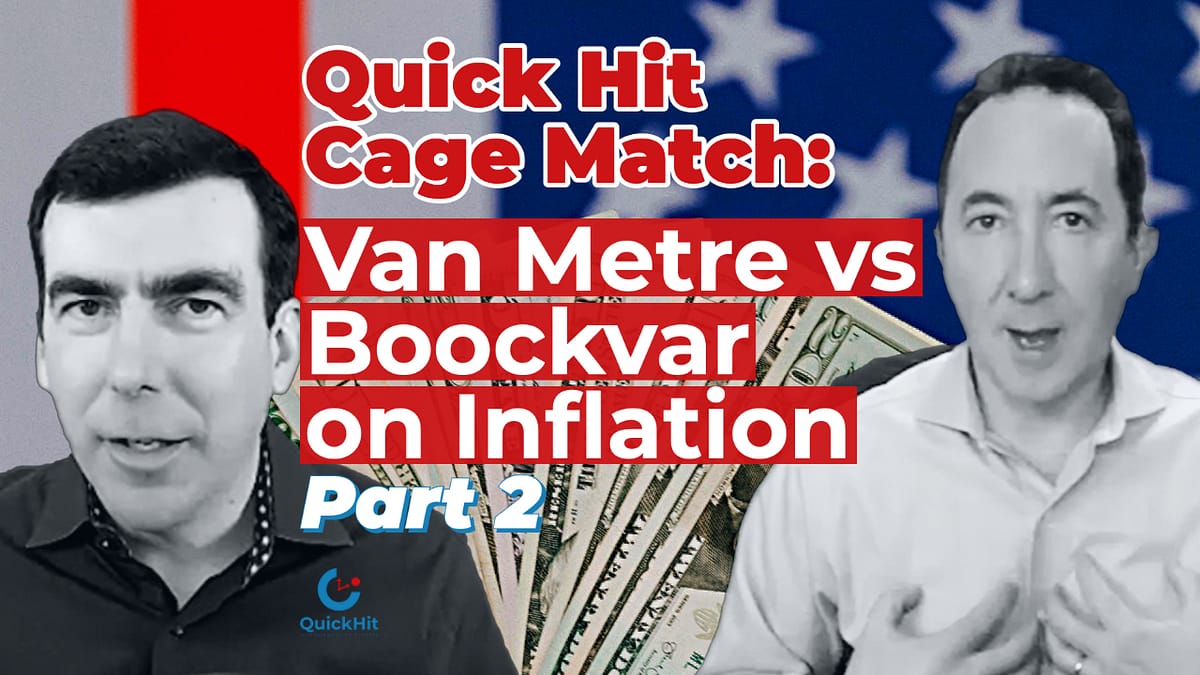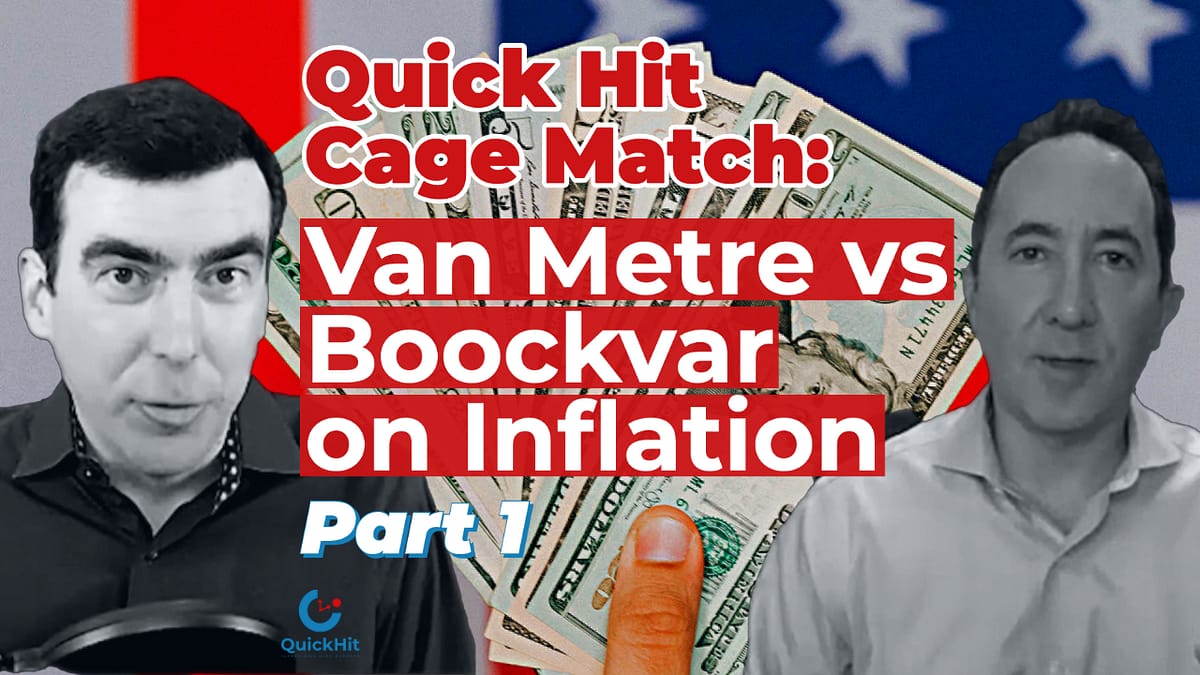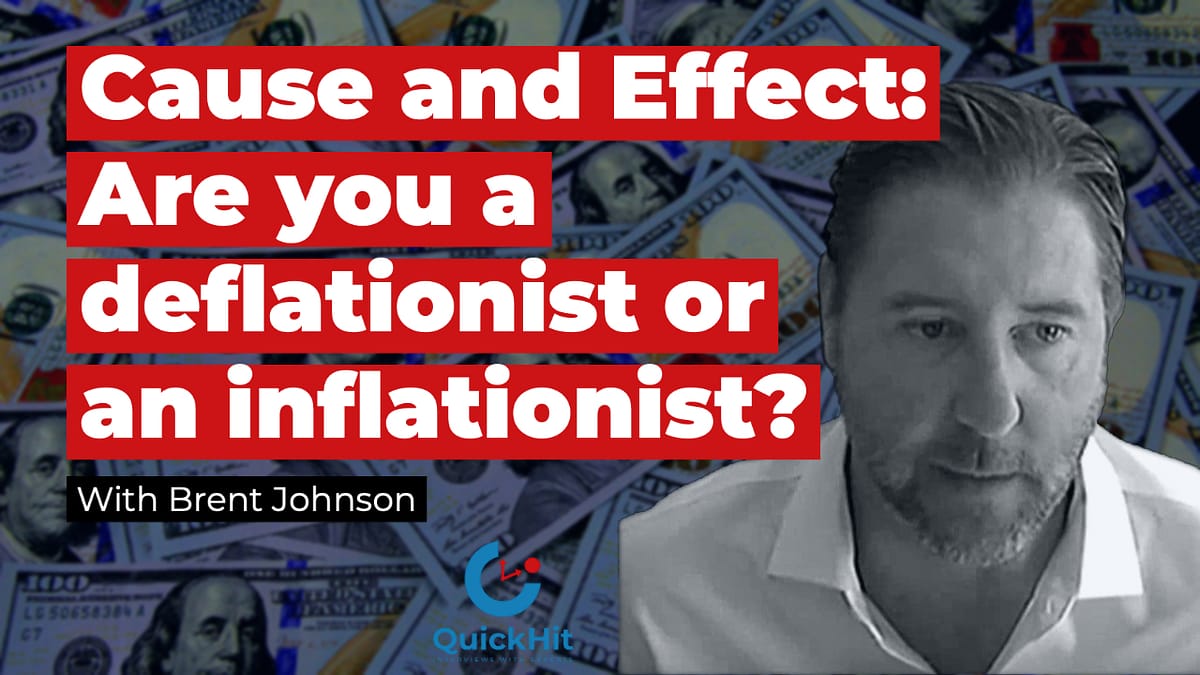We had a chop last week. And towards the end of the week, we had the CPI print, which put a damper on markets. In this episode, we’ll talk about CPI and peak inflation, which people have been talking about for months, but we haven’t quite hit it yet.
Of course, we’re going to talk about the hot dollar, and we’re going to talk about fuel inflation and things like refining capacity and even a nat gas plant explosion that happened here in Texas last week.
And then finally, what is going on in the week ahead?
Key themes:
- CPI & “Peak Inflation” – Core CPE, hand off from goods to services, Fed policy and markets.
- Hot dollar – DXY has only been higher in Feb 1985 and Jan 2002. Fed, Dollar, Yellen, etc.
- Fuel Inflation – Refining capacity, natgas explosion.
This is the 22nd episode of The Week Ahead, where experts talk about the week that just happened and what will most likely happen in the coming week.
Follow The Week Ahead experts on Twitter:
Tony: https://twitter.com/TonyNashNerd
Sam: https://twitter.com/SamuelRines
Tracy: https://twitter.com/chigrl
Listen to the podcast version on Spotify here:
Transcript
TN: Hi everybody. And welcome to The Week Ahead. My name is Tony Nash. We are with Tracy and Sam today. Albert is in an undisclosed location, so he won’t be joining. But we’ll have a good show anyway. So before we get started, please like and subscribe. And as importantly, please comment. We really appreciate those. We respond to all of them. And it’s great to have the engagement.
This week. We had chop, as Sam talked about. And towards the end of the week, we had the CPI print, which really put a damper on markets. So we’re going to talk about a few things. First, CPI and peak inflation, which people have been talking about for months, but we haven’t quite hit it yet. Of course, we’re going to talk about the hot dollar, and we’re going to talk about fuel inflation and things like refining capacity and even a natgas plant explosion that happened here in Texas last week. And then finally, what is going on in the week ahead?
So first, CPE was all of the focus for the last half of the week. Sam put out an amazing note, a couple of amazing notes this week talking about inflation and what the Fed will do. So we’re looking at a chart right now on core CPI. And Sam, can you walk us through why the core matters and what’s happening there?
SR: Sure. The core matters because it strips out food and energy, and that’s what the Fed likes to look at. Right. That’s what the market looks at for underlying inflation dynamics generally. It’s kind of a quick and easy number. Luckily, it’s accelerated by some marginal amount on a month over month, year over year basis. Cool. Nobody should really care about that, because when you break apart the actual numbers, the entirety of the deceleration and core inflation was in the good side. We know that goods are coming down, particularly on a year over year basis. They want skyrocket and to the right, that’s just not sustainable.
TN: Is that because of the inventories that were accumulated at retailers and other folks.
SR: That’s part of it. Used cars as well. There’s airline fares are in there, too. So that’s going to be somewhat of a problem as we move forward.
The interesting thing to me is when you actually dig into it. Yeah. Core goods accelerated, but core services, which are far stickier and far more difficult for the Fed to kind of get a hold of accelerated.
TN: Right. So let’s put that up now and then. Yeah. So we’ve got your chart up now about the commodities, less food and energy and then services, less energy. So can you help us understand what that means?
SR: Yeah, sure. That’s just call it the core CPI broken into services and goods. Right. So it strips out food and energy from both of them. And then you kind of get a more of a feel of what’s really happening in the underlying economy. And there was always this big debate among economists about when this hand off from goods to services was going to happen and how that was going to affect the economy. And unfortunately for the Fed and for market participants, that hand off is happening.
You can see it in the data and you can see it in the inflation data in particular. It’s happening. The problem is that you don’t have goods coming down fast enough and you have services moving up way too quickly. And those two components are unlikely to give the Fed any sort of comfort in the next six to nine months.
TN: Okay. With services moving up, does that mean that wages, say on the lower end around things like hospitality and restaurants, does it mean that those wages are going up?
SR: Not directly. There’s some implied probability that you’re beginning to see some movement there, but you’ve seen quite a bit of movement at a leisure and hospitality in particular in terms of the wage gains there.
Unfortunately, the wage gains can be pretty large in magnitude, a 5 to 9 percent type acceleration year over year in leisure and hospitality wages. But it doesn’t really move the needle in terms of overall wage gains because those tend to be the lower end of the income scale.
TN: Okay. So I saw some data this week looking at credit capacity, and it looks like US consumers put record amounts on credit cards in April and May. Does that make you nervous? And I’m not talking about the high end of consumers. I’m talking about the middle and lower end of consumers because there’s a lot more of them. Right. Does that make you nervous?
SR: Yes. And it goes to the conversation that Tracy and I are going to have in a little bit here. A lot of it is due to gasoline. Right. You don’t go to a pump and typically pay with cash. I mean, you did that 10, 15, 20 years ago. You typically go to the pump and pay with a credit card.
So when you begin to have prices like this, move this quickly on the pump side of things and grocery side of things, you tend to have a move up in credit card usage that’s translating to debt because you simply don’t have wages keeping up. Yes, wages are ticking higher, but they’re not keeping up. So the lower end of the consumption, called the lower two quartiles, they are struggling with this, and that is going directly on the credit cards.
TN: I’ve talked to a few people this week about how wages in developed economies work. And if we were in an emerging economy, middle income economy, there would be more flexibility on wages because wages rise faster generally in those economies. But in, say, the US, wages really don’t rise fast.
So on some level, it’s a bit hard for people to understand that wages in the US are generally inflexible, especially at the lower and middle ends. And so it is kind of zero sum. Right. So as gas and food prices rise, that takes away consumption from other areas, right?
SR: It does. And the other thing that it leads to is more of a trend towards unionization and other forms of labor activism. And you’re going to continue to see labor activism if wages continue to trail this far behind inflation. That is an underlying trend that I think is going to be somewhat important for understanding how markets react because labor was fairly cheap, give or take for US businesses in particular.
If you begin to have more unionization, if you begin to have more of an activist labor movement, that is going to be a thing to corporate earnings, not just for the next year. That’s going to be a thing for corporate earnings going forward.
TN: Okay. So let’s talk about corporate earnings. As we look at, say, Q2 corporate earnings, it doesn’t look good, right? I mean, generally the expectation is that their margin compression, all this other stuff really starts to sting in Q2 Is that right?
TS: It depends on the industry as well, because what we’re seeing and what I’m hearing as far as obviously oil companies are going to do extremely well so are refiners right now. But we are also seeing the hospitality industry do extremely well as far as travel is concerned, because we’re seeing a lot of pent up demand where people are not spending retail spending, but they’re still spending for trips.
If we look at US air bookings, for example, there are 93% of 2019 levels for Europe. We’re at 95% for South America. We’re at over what we were in 2019 to the Caribbean. And we’re also seeing soaring hotel bookings right now, even with cost pushing higher and ticket prices higher. So I think that Q2 is going to be very good actually, for, say, oil and gas and the hotel industry. But then as we move into Q3, I think we’re going to see a big hangover in that area in the fall.
SR: And to Tracy’s point, hotel bookings are above 2019 levels and the average price of those rooms through the roof. So you multiply those two together to get your average room rate and Occupancy, those are some big numbers that we’re going to see over the summer. To Tracy’s point, there’s going to be a lot of people that blow it out of the water in terms of earnings, and there’s going to be a lot of people that surprise the downside.
If you were a work from home darling, that was expecting work from home and those dynamics to be permanent and you’re in trouble. Right. That’s the target problem. People aren’t buying goods. They’re going places. And the bifurcation there is going to become stark as we move through the second quarter and probably into the third quarter.
TN: Really interesting. Okay. And then I guess the question that is probably overanalyzed, but people are waiting for is what does this mean for the Fed? They’re still on target for 50 in June, 50 in July and 50 in September. Is that your assessment? And maybe 25 in November? I think.
SR: 50 in November, 50 in December.
TN: 50 in November, 50 in December? Wow. So we’re going back to the 90s.
SR: Basically fully priced in the market.
TN: Is there any chance that they will accelerate beyond 50? Like, would they front load any of that just to shock the system?
SR: No, because I don’t think they want to shock the system. The Fed already has a credibility problem. If you move from 50 to 75, you create more of a credibility problem because you forward guided 50-50, and now all of a sudden you’re telling the market you’re doing 75, the market is just going to stop believing and they’re going to push the Fed and they’re just going to push back and it’s going to be a huge problem.
So I don’t think they’re surprised on that front. They may tweak the balance sheet. That’s a little bit of an easier move to make. Right. You can speed up the MBS role. You can pick up a little bit of the front end roll on US Treasuries, you can tighten that way and have it not be as much of a shock to the system.
TN: Okay.
SR: But have it be pretty interesting on the tightening front.
TN: Okay. But let’s dig into that, though. I’m sorry to spend too much time on our first topic, but if they accelerate the MBS stuff, housing is already kind of at a standstill over a two month period. Two to three month period.
A lot of people have had wealth effects because of the rapidly inflated house prices. So if they accelerate MBS, that perception of housing wealth collapses even more. Right. And so does that have relatively like a multiplier effect on the deceleration of consumption?
SR: It does. But that transmission is pretty slow generally, and you had a significant amount of call it front running against the housing market to take out equity. So I would push back a little bit on a collapse in transactions is going to have a big effect. What you really need to see is pricing actually coming down because it’s about pricing.
TN: Pricing coming down.
SR: Yeah. And pricing. The data is so delayed that it’s almost worthless.
TN: Nominal housing prices.
SR: Yes. But you’re still seeing housing prices hold up pretty well for most of the country. So until you really begin to see a crack there, I don’t think the wealth effect really takes hold from houses.
But you’re probably talking about a September, October type time frame for home prices to be weighing on people’s minds.
TN: Okay. It feels like over the past few months things have changed pretty dramatically. Expectations and these sorts of things. I know you’ve been talking about this for months, but I think the world is just catching up to it. And two months ago everyone said, oh, it’s all priced in. And then we get a day like Friday where obviously it’s not priced.
SR: I’ll stop after this but the interesting part about Friday was it wasn’t just call it the November December meetings getting priced higher for Fed rate hikes. It was March and May of next year that also saw pretty significant volumes and saw the pricing of the Fed movement get pushed pretty hard. So you’re seeing movement across a very long time horizon.
You’re talking twelve months out is kind of what people are pushing on now. So that really creates a different dynamic. But it’s a different dynamic to have eight or ten basis points priced in in September or November. It’s a bigger deal to have quite a bit of tightening priced in for December and March. Those are some out months those begin to really move markets on the margin.
TN: All of this in a midterm year. All of this in the midterm election year.
SR: It’s really painful all around, right? It’s painful all around. But I think the Fed kind of plays second fiddle to Tracy’s point on energy and how that flows through the consumer and the consumer psyche because that is critical at this point.
TN: Okay. So speaking of second fiddle let’s move on to the hot dollar and Fed playing second fiddle to Janet Yellen as Tracy has said before. We’re looking. At DXY that is the third highest it’s been ever it was very high in the mid eighty s it was very high in I think February 2002.
We’ve got that chart up now and now it’s hitting rates that it hasn’t hit for years so we have the Fed doing certain things to tame but we also have things like crude and other commodities that are rising in dollars. Terms. And it looks like the dollar is being pushed up to fend off some of that. So, Tracy, can you talk us a little bit through your view of kind of Yellen and her dollar bias and then impacts that you expect to see.
TS: She said since the beginning she wanted a strong dollar. Right. The problem is that right now this is a disastrous recipe for emerging markets right now with high energy prices and high dollar. And it’s no wonder we’re seeing huge outflows in emerging markets right now as far as investments are concerned. And so really that’s who’s going to feel the pain the most that could throw us to a global recession, for sure.
TN: Right.
SR: To that point, Europe is in a lot of trouble, and the Dixie is basically a measurement of euros and yen. That’s right. If you want to talk about a central bank that’s lost credibility, there’s none better than the ECB and Madame Lagarde and that wonderfully stupid speech that she gave this week, it was spectacularly bad.
TN: It’s what happens when you have a lawyer running monetary policy.
SR: They’re raising rates, and we have them, too. Anyway, moving on. So there is an interesting kind of dynamic there where you basically had the ECB for the first time in forever, say we’re going to raise rates like they just told us straight up they were going to do it and they got the wrong reaction across markets.
The currency didn’t go up. The currency didn’t strip. The currency looked pretty ugly that day. And then you’ve got yen sitting at 135 because they’re still doing yield curve control and it doesn’t look like they’re ever going to end it. So you have the Fed going in the exact opposite direction or much quicker than the rest of the world. In the DM world in particular.
That’s a recipe for a stronger dollar. And until you either get the ECB to smarten up or you get YCC brackets moved, yield curve control brackets moved by the bank of Japan, there’s no stopping the Dixie from moving higher. Right. It’s a two currency, two currencies basis.
TN: Remember Abenomics, when they were fighting to get 2% inflation in Japan.
SR: Yes.
TS: They’re still fighting. That’s why you can’t see inflation, it’s incredible.
TN: Yeah. Tracy, if we continue to see the dollar strengthen, do you think that has much impact on, say, crude prices and fuel prices?
TS: I know that everybody likes to think it’s a one to one correlation. Right. We think stronger dollar commodities. But it’s really not a one to one correlation, especially when you’re talking when you have actual supply demand issues. Right. Like we have a supply deficit across. So a stronger dollar is not going to hurt oil prices when you have real supply demand issues. Whereas if you look at something more like gold, the stronger dollar is not necessarily great for gold right now.
TN: Yeah. So I love it when people like talking about correlations of oil and dollar because many of them don’t realize that actually the positive correlation between oil and dollar is more frequent than many people want to admit, and it’s more persistent than many people want to admit.
So the kind of go to there’s a negative .9% correlation between oil and the dollar. It’s just not true. It’s a fiction.
SR: And the dynamic changed when the US became a major producer of oil.
TN: Right.
SR: That completely changed the dynamic. So if you’re not paying attention to the structural breaking system where the US became the world’s largest producer of hydrocarbons, you don’t know what you’re doing.
TN: Right. So who hurts the most? I think we mentioned EMs, but kind of who hurts the most, aside from Sri Lanka, which we already know? Is it like North Africa, those types of places? Is it Southeast Asia? Just off the top of your head, we didn’t rehearse this, so I’m just curious, what do you think hurts the most?
TS: I think you’re going to see a lot of problems in Africa for certain only because a lot of the OPEC producers there are struggling themselves already. Right. All of those people are the ones that are contributing majorly to the quota misses right now. So I think you’re going to see real pain there over Asia, I would say.
TN: Okay, Sam?
SR: Yeah, I would agree with Tracy. North Africa, East Africa, those look very vulnerable, particularly when you combine food costs with gasoline costs and oil. It’s kind of a toxic mix because if you have oil at 125 Brent, there’s an incentive that you want to pump and the people expect you to pump and buy them food. And if you can’t pump and buy food, then you’re basically an illegitimate government in North Africa.
TN: Right. Which is just trembling all around. Okay, let’s move on to energy prices and gasoline and petrol prices. Of course, we just hit this week again, I think three or four times this week we hit record prices for gasoline. And of course, that’s happening all around the world.
I think in the UK it’s £2 a liter or something like that. In the US, it broke $5 a gallon on average. I think 5.01 this morning, Patrick Dejan was saying that. Tracy, can you walk us through? We’ve mentioned this a couple of weeks ago, but in a bit more detail about what’s happening with refining capacity in the US and why this is such a big deal?
TS: Right. The last largest Greenfield project that we had was 1977. We’ve had a lot of brownfield projects, meaning adding to capacity to already existing refining facilities. However, right now we sort of peaked in 2018 and 19 as far as refining capacity is. And now we’re starting to come down again because we’re starting to see more closures, we’re seeing more unplanned outages.
These facilities are very old. So the operable capacity has been on the decline for the last few years. And if you look at Europe and Europe, it’s even worse. Right. So, I mean, Europe already has a problem, too, and that’s why they buy most of their diesel from Russia, which is going to affect them, because the diesel that they buy from them is seaborne. Right. All of it, which it falls under sanctions.
TN: And they can’t get insurance for those vessels.
TS: Yeah. And so they’re going to have a lot of problem. just to put a little tangible example, there’s a news here in Houston this week that I think it’s a Lyondell refinery that’s being closed, and that refinery is over 100 years old. Yes, our refineries are old. They’re aging facilities. They need a lot of maintenance. And we just really haven’t built out enough capacity for the amount that is coming offline over the last few years.
TN: So, Tracy, I know this is a little bit of a request, but we’re sending $40 billion to countries around the world to do different things. Would it not make sense to have some sort of government incentive for midstream companies to actually build refineries?
TS: Well, yeah, absolutely. I mean, infrastructure projects as far as the oil industry is concerned. If you look at the government’s complaining about oil companies are making so much money. However, where were they when they were in the red and racking up the debt? They were nowhere. How many times do we bail out the Airlines and the auto industry? The oil industry never got any help.
TN: Because they’re bad, tracy, oil companies are bad. They’re all my neighbors. But you would think they’re all bad, evil people.
TS: This is causing… Where our refinery operable at capacity? We’re at 94.2% refining right now, which is off the charts. Good. That means good news for your refining stocks if you own any. But we’re pushing it. We’re using it as much as we’re producing. Right.
TN: Let’s say somehow people came to their senses and said, look, we need to incentivize new refineries. How much just off the top of your head? Ten, $20 billion. Is it $100 billion? Just to get things started? How much do you think that would cost? Since we’re throwing money around.
TS: Since we’re throwing money around, I think if you could throw 10 billion, 20 billion at it, you could get some good projects going or tax incentives or something like that for current refineries to be able to build out or upgrade things of that nature. There’s a lot of things the government could do to help boost refining capacity.
TN: Okay. So while we’re throwing money around, would it make sense to reconfigure some of those refineries to refine light sweet Texas crude instead of, say, I don’t know, Venezuelan crude?
SR: Yes, it’s pretty simple. We built the right type of refining for a certain point, but we didn’t build the right type of refining for now. Yes, we would need to upgrade all of them, and it’s going to be a pretty significant issue.
The other really important thing that I think gets overlooked a lot is that even if you begin these projects now. It’s not a solution for several more years. By several more years, three to four at a minimum, kind of where you would expect these to begin to come online.
And the question is, what does the oil market look like at that point? What kind of mix do we have? So you have to make some fairly large assumptions about what your input mix is going to be down the road. So, yeah, I do think that it would be worthwhile to at least upgrade the current refineries, but I think that’s kind of a pipe dream.
TN: Okay. So while we’re throwing $40 billion overseas, we could take half of that and build new refineries and reconfigure refineries with American crude oil. Am I misunderstanding this?
SR: No.
TN: I just want to hammer the point home again. Okay, great. Thank you, guys. We had a really choppy week. We had a lot of kind of bad news come out. What are we looking forward to next week? Is it kind of more the same? Are we still in a really rough place and the Fed meetings this week, some announcements. I don’t think it’s going to surprise anybody, but what else are you looking for this week?
TS: Pretty much the same. I think we’re kind of stuck in this market low for a while now. So I figure you still see chop, you probably see oil sideways to up again. I expect that trend to pretty much continue into the summer until we really start to see some demand destruction, which we’re just not seeing enough yet.
So I think headed into fall, we have a better chance of seeing oil prices come down because again, I think that we’re sort of going to have a travel hangover and everybody’s going to get home and they spend a bunch of money on their credit cards and the economy is not that great. So that’s what I’m looking at. And again, for the week ahead, I think more of the same.
TN: Sam?
SR: Yeah, you have a million meetings next week of central banks. I think that’s really what the markets are going to key off of. And it really depends who says the most dumb stuff. And it’s going to be a competition because you have Powell and then you have the Bank of Japan. So we’ll see if maybe you get a little bit of a bracket move on yield curve control that would make things a little more spicy across markets. And we’ll see what Powell is capable of messing up when it comes to forward guidance during the press conference.
So I would say it’s more the same, but there’s a likelihood that markets are about as hawkish as they can be going into the meeting and that Powell doesn’t want to push markets more. So there may be a little bit of a rally off Powell just not being an uberhawk, and that might be positive, but I would say you’re in for some serious chop, particularly across the rates markets, currency markets.
And when it comes to equity markets, I think it’s going to be exactly what Tracy and I talked about earlier. It’s going to be the story of travel over retail.
TN: Okay? So next week, let’s talk about who said the stupidest central bank statement. Okay?
SR: Perfect.
TN: You got it.
SR: Does that work?
TN: Very good. Okay. Thanks, guys. Thank you very much. Have a great weekend. And have a great weekend.
SR: You, too. Tony.


